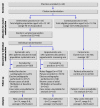Screening versus routine practice in detection of atrial fibrillation in patients aged 65 or over: cluster randomised controlled trial
- PMID: 17673732
- PMCID: PMC1952508
- DOI: 10.1136/bmj.39280.660567.55
Screening versus routine practice in detection of atrial fibrillation in patients aged 65 or over: cluster randomised controlled trial
Abstract
Objectives: To assess whether screening improves the detection of atrial fibrillation (cluster randomisation) and to compare systematic and opportunistic screening.
Design: Multicentred cluster randomised controlled trial, with subsidiary trial embedded within the intervention arm.
Setting: 50 primary care centres in England, with further individual randomisation of patients in the intervention practices.
Participants: 14,802 patients aged 65 or over in 25 intervention and 25 control practices.
Interventions: Patients in intervention practices were randomly allocated to systematic screening (invitation for electrocardiography) or opportunistic screening (pulse taking and invitation for electrocardiography if the pulse was irregular). Screening took place over 12 months in each practice from October 2001 to February 2003. No active screening took place in control practices.
Main outcome measure: Newly identified atrial fibrillation.
Results: The detection rate of new cases of atrial fibrillation was 1.63% a year in the intervention practices and 1.04% in control practices (difference 0.59%, 95% confidence interval 0.20% to 0.98%). Systematic and opportunistic screening detected similar numbers of new cases (1.62% v 1.64%, difference 0.02%, -0.5% to 0.5%).
Conclusion: Active screening for atrial fibrillation detects additional cases over current practice. The preferred method of screening in patients aged 65 or over in primary care is opportunistic pulse taking with follow-up electrocardiography.
Trial registration: Current Controlled Trials ISRCTN19633732 [controlled-trials.com].
Conflict of interest statement
Figures
Comment in
-
Diagnosing atrial fibrillation in general practice.BMJ. 2007 Aug 25;335(7616):355-6. doi: 10.1136/bmj.39266.497396.BE. BMJ. 2007. PMID: 17717334 Free PMC article.
-
What is the best method of detecting atrial fibrillation in people aged 65 years and older?Nat Clin Pract Cardiovasc Med. 2008 Mar;5(3):138-9. doi: 10.1038/ncpcardio1063. Epub 2007 Nov 20. Nat Clin Pract Cardiovasc Med. 2008. PMID: 18030290 Clinical Trial. No abstract available.
-
Systematic or opportunistic screening was more effective than usual care for detecting new cases of atrial fibrillation.Evid Based Med. 2008 Apr;13(2):45. doi: 10.1136/ebm.13.2.45. Evid Based Med. 2008. PMID: 18375698 No abstract available.
References
-
- Wolf PA, Abbott RD, Kannel WB. Atrial fibrillation as an independent risk factor for stroke: the Framingham study. Stroke 1991;22:983-8. - PubMed
-
- Atrial Fibrillation Investigators. Risk factors for stroke and efficacy of antithrombotic therapy in atrial fibrillation; analysis of pooled data from five randomised controlled trials. Arch Int Med 1994;154:1449-57. - PubMed
-
- Wilson JMG, Jungner G. The principles and practice of screening for disease WHO Public Health papers. Geneva: World Health Organization, 1968:34.
Publication types
MeSH terms
Associated data
LinkOut - more resources
Full Text Sources
Other Literature Sources
Medical

